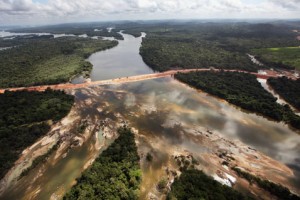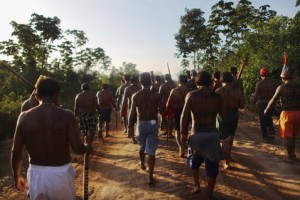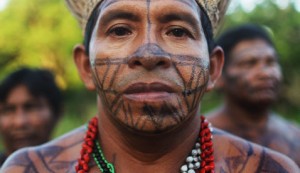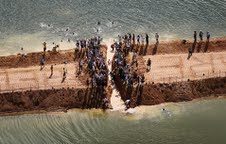Belo Monte Dam: Not Just a Threat to the Environment
The Belo Monte Dam project along the Xingu River had its preliminary plans drawn under Brazil’s military dictatorship and was a highly controversial environmental project from the onset. However, construction of the dam has continued despite its serious backlash, mainly due to the influence of Brazil’s developing economy. But the indigenous population along the Xingu River is increasingly concerned about their fate, as the dam comes with a high potential for environmental degradation and the establishment of new communities on their land.

Brazil’s 2011-2020 energy-expansion plan is decisively dependent upon output from Brazil’s large hydroelectric dams, and the Belo Monte Dam is projected to bring about a 22 million home surplus once the Brazilian government completes the project. [i] It views the dam as a vital and legitimate development project, one that is projected to sustain economic growth as demands for dependable water sources, power generation and irrigation systems increase.[ii] However, the dam is charged with threatening the religion and culture of the Xingu Indians, or the set of beliefs that they deem essential to their civilization, and even worse, their very existence.
To all of the Xingu natives, except the Kayapo and Suya tribes, the river signifies the “house of God,” which is now vulnerable to destruction with the arrival of the dam. The symbolic ritual of exchanging water between tribes for the indigenous people denotes a communal relationship and the interconnectedness of the earth, water, and mankind. In this culture, water therefore both represents and facilitates social unity, an aspect of life that the government cannot replace through simple compensation.[iii]
The dam’s construction will require a diversion of the Xingu River, which will create a lasting drought on the “Big Bend” part of the river.[iv] The drought will severely inhibit agricultural practices, as severe droughts can be expected to augment the flammability of forests and thus increase the risk of losing crops and livestock.[v] This can be expected to affect the natives’ economies and their ability to survive. Usually the main powerhouse of dams is placed at the base, allowing the water to come out of the turbines and follow in a path down to the river. However, in the Belo Monte Dam “most of the river’s flow will be detoured from the main reservoir through a series of canals interlinking five dammed tributary streams, leaving the ‘Big Bend’ of the Xingu River below the dam with only a tiny fraction of its normal annual flow.”[vi] As a result, the Juruna and Arara indigenous tribes that live nearby in the Paquicamba and Arara regions, located near the ‘Big Bend,’ will encounter extreme difficulty in finding clean water sources. They will ultimately suffer from a deficiency of food and the spread of diseases due to the lack of water.[vii]

The Belo Monte Dam follows similar projects with correspondingly negative implications for indigenous communities in Brazil. In 1989, the Balbina hydroelectric plant flooded nearby villages and contaminated the only vital water source in the area. In referencing the incident, an Al Jazeera article from May 17 notes that the Balbina hydroelectric plant “drowned fauna, flora and contaminated fresh water supplies, resulting in food and health problems.” The flood displaced eight Atroari indigenous villages along the Uatuma River, but only two of the Atroari villages were ever relocated.[viii]
In a comparable case during April of 2002, the Inter-American Development Bank (IDB) financed the Cana Brava dam on the Tocantinus River in the Amazon that flooded the region inherited by the Avás-Canoeiros indigenous population. The project developer has yet to negotiate compensation and relocation with the people in a transparent way. Over 1,000 families were affected by the flooding but according to the Avás-Canoeiros people, fewer than 300 inhabitants were offered relocation and compensation entirely.[ix]
Experts anticipate that the Belo Monte Dam project will bring further detrimental effects to the Xingu inhabitants.[x] The Belo Monte Dam requires the excavation of two large canals, which will flood the surrounding forest area, thereby displacing fifty thousand Xingu Indians within the Altamira community.[xi] Government officials have legitimized the dam’s construction by claiming that upon the completion of the project the natives will have plenty of fishing as well as more than enough water that is required for traveling along the Xingu River.[xii] The statement, however, fails to accurately portray the negative impacts a flood would have on the region’s flora and fauna, which is critical to the Xingu natives’ survival, nor does it mention the spread of diseases or the fact that a large number of tribes would be left homeless.[xiii]

The Brazilian government tried justifying the harmful impacts of the Belo Monte Dam with compensation and resettlement for the Xingu natives. However, past offers of reimbursements by the government have failed to adequately compensate the indigenous for their losses. Additionally, two indigenous groups currently reside alongside the dam and its central powerhouse, an area known as “the dry stretch,” but the government’s environmental study failed to identify their reserves as “directly impacted,” thus negating the groups’ rights to consultation and compensation. The Human Rights Commission of the Organization of American States (OAS-ICHB) claimed that the insufficient examination and repayment schemes violate the international accords, an agreement to which Brazil is a signatory.[xiv]
Brazil’s 1988 constitution initially required congressional approval of any dams threatening indigenous land, which necessitated changes in the original designs of Belo Monte to avoid flooding the Xingu natives’ reserves. Upstream dams were not even considered by the government in its designs for Belo Monte,[xv] which is significant as upstream dams can cause permanent flooding.[xvi] However, in 2005 the government began demonstrating less consideration for the people of Xingu when the senate abruptly approved the Belo Monte Dam “under an ‘urgent, super-urgent’ regime.” This decision did not include the prior consultation of the Xingu Indians as required by the Brazilian constitution.[xvii]

A video depicting the Drop of Water Movement was posted online on November 16, 2011, in attempts to involve more Brazilian citizens in the construction plans of the Belo Monte Dam. In response, close to a thousand indigenous people from the Amazon region participated in a week long protest outside the Brazilian Congress to express their grievances regarding human rights violations, including the lack of consultation in the Belo Monte Dam project, especially concerning land titles.[xviii] When lobbying for the Guarani-Kaiowa tribe’s land, the son of the tribe’s former chief Valmir Gomes stated, “we’ve gone through many difficulties, and I can’t even walk in the cities because of the risks,” and “we need the demarcation so that we can freely walk on our own lands.”[xix] Such statements underscore the indigenous’ need for land titles so they do not have to live in fear.
Between June 15 and June 23 of 2012, the People’s Summit took place in Rio de Janeiro with 15,000 people in attendance, including many indigenous groups that engaged in various forms of performance art to express themselves. [xx] A number of attendees expressed the indigenous groups’ frustrations at the controversial construction of government-backed dams.[xxi] According to an Al Jazeera article published on June 22, a young delegate from Canada representing the Indigenous Environmental Network named Ta’Kaiya who attended the People’s Summit said, “the development – the drilling, mining and damming – is affecting everyone, our communities and the Earth, our home and the only planet we have.”[xxii]

Threats to the Xingu Indians mount as the government attempts to continue construction on the Belo Monte Dam project through investment programs such as Brasil em Acão and the Program to Accelerate Growth.[xxiii] As previously explained, the Brazilian government is going forth with the construction of the Belo Monte Dam to further its energy expansion, but according to the non-profit organization Amazon Watch, during the region’s dry season, the dam is only able to utilize 39 percent of its total capacity, resulting in the sure devastation of the Xingu natives’ lives, culture, and natural habitat at the hands of this energy-inefficient dam installation. [xxiv] Amazon Watch has suggested “retrofitting existing hydroelectric infrastructure” as a sustainable alternative to the Belo Monte Dam, a prospect that would be both energy efficient and non-threatening to the Xingu Indians. The government might start improve the efficiency of pre-existing dams by “[reducing] the startling amount of energy lost during transmission, [replacing] energy-inefficient household products, and [updating] old and dialing generators.”[xxv] Retrofitting the Belo Monte Dam would be a worthy alternative and may ultimately prove critical to the survival of the Xingu natives.
Please accept this article as a free contribution from COHA, but if re-posting, please afford authorial and institutional attribution.
Exclusive rights can be negotiated.
Monga Bay, March 23, 2012. Accessed June 19, 2012. http://news.mongabay.com/2012/0323-fearnside_op-ed_belo_monte.html.
[ii] Brody, Thyra. “Damming Brazil.” E-Research: A Journal of Undergraduate Work
3.1 (2012). Accessed June 19, 2012. http://journals.chapman.edu/ojs/index.php/e-Research/article/view/308/602.
[iii] Brody, Thyra. “Damming Brazil.” E-Research: A Journal of Undergraduate Work
3.1 (2012). Accessed June 19, 2012. http://journals.chapman.edu/ojs/index.php/e-Research/article/view/308/602.
[iv] Amazon Watch. “Stop the Belo Monte Monster Dam.” Accessed June 19, 2012.
http://amazonwatch.org/work/belo-monte-dam.
[v] Li, Wenhong, Fu Rong, Negron Juarez Robinson I., and Fernandes Katia. “Observed
Change of the Standardized Precipitation Index, its Potential Cause and Implications to Future Climate Change in the Amazon Region.” The Royal Society 363. 1498 (2008): 1767-1772. Accessed June 19, 2012. Doi: 10.1098/rstb.2007.0022.
[vi] “Belo Monte Dam: A Spearhead for Brazil’s Dam-Building Attack on the Amazon?”
Monga Bay, March 23, 2012. Accessed June 19, 2012. http://news.mongabay.com/2012/0323-fearnside_op-ed_belo_monte.html.
[vii] Amazon Watch. “Stop the Belo Monte Monster Dam.” Accessed June 19, 2012.
http://amazonwatch.org/work/belo-monte-dam.
[viii] “Belo Monte: Brazil’s Damned Democracy.” Al Jazeera, May 17, 2012. Accessed
June19,2012.http://www.aljazeera.com/indepth/opinion/2012/05/2012515144822206262.html.
[ix] Bank Information Center. “Cana Brava Hydroelectric Project.” Last modified June
25, 2012. http://www.bicusa.org/en/Project.6.aspx.
[x] “Belo Monte: Brazil’s Damned Democracy.” Al Jazeera, May 17, 2012. Accessed
June19,2012.http://www.aljazeera.com/indepth/opinion/2012/05/2012515144822206262.html.
[xi] Amazon Watch. “Stop the Belo Monte Monster Dam.” Accessed June 19, 2012.
http://amazonwatch.org/work/belo-monte-dam.
[xii] “Belo Monte: Brazil’s Damned Democracy.” Al Jazeera, May 17, 2012. Accessed
June19,2012.http://www.aljazeera.com/indepth/opinion/2012/05/2012515144822206262.html.
[xiii] Brody, Thyra. “Damming Brazil.” E-Research: A Journal of Undergraduate Work
3.1 (2012). Accessed June 19, 2012. http://journals.chapman.edu/ojs/index.php/e-Research/article/view/308/602.
[xiv] “Belo Monte Dam: A Spearhead for Brazil’s Dam-Building Attack on the Amazon?”
Monga Bay, March 23, 2012. Accessed June 19, 2012. http://news.mongabay.com/2012/0323-fearnside_op-ed_belo_monte.html.
[xv] “Belo Monte Dam: A Spearhead for Brazil’s Dam-Building Attack on the Amazon?”
Monga Bay, March 23, 2012. Accessed June 19, 2012. http://news.mongabay.com/2012/0323-fearnside_op-ed_belo_monte.html.
[xvi] Brody, Thyra. “Damming Brazil.” E-Research: A Journal of Undergraduate Work
3.1 (2012). Accessed June 19, 2012. http://journals.chapman.edu/ojs/index.php/e-Research/article/view/308/602.
[xvii] “Belo Monte Dam: A Spearhead for Brazil’s Dam-Building Attack on the Amazon?”
Monga Bay, March 23, 2012. Accessed June 19, 2012. http://news.mongabay.com/2012/0323-fearnside_op-ed_belo_monte.html.
[xviii] “Belo Monte: Brazil’s Damned Democracy.” Al Jazeera, May 17, 2012. Accessed
June19,2012.http://www.aljazeera.com/indepth/opinion/2012/05/2012515144822206262.html.
[xix] Sibaja, Marco. “Brazil’s Indigenous Awa Tribe at Risk.” The Huffington Post, June 6, 2012. Accessed June 19, 2012. http://www.huffingtonpost.com/2012/06/06/brazils-indigeneous-awa-tribe_n_1574374.html
[xx] Rio+20 Portal. “People’s Summit for Social and Environmental Justice in Defense of the Commons.” Accessed June 19, 2012. http://rio20.net/en/events/peoples-summit-for-social-and-environmental-justice/
[xxi] The Associated Press. “People’s Summit: an Alternative to UN Convention.” Herald
Online, June 21, 2012. Accessed June 26, 2012. http://www.heraldonline.com/2012/06/21/4063339/peoples-summit-an-alternative.html
[xxii] Nallu, Preethi. “Alternative voices from Rio+20.” Al Jazeera, June 23, 2012. Accessed June 24, 2012. http://www.aljazeera.com/indepth/features/2012/06/2012622175745190650.html
[xxiii] Amazon Watch. “Stop the Belo Monte Monster Dam.” Accessed June 19, 2012.
http://amazonwatch.org/work/belo-monte-dam.
[xxiv] “Belo Monte Dam: A Spearhead for Brazil’s Dam-Building Attack on the Amazon?”
Monga Bay, March 23, 2012. Accessed June 19, 2012. http://news.mongabay.com/2012/0323-fearnside_op-ed_belo_monte.html.
[xxv] “Belo Monte: Brazil’s Damned Democracy.” Al Jazeera, May 17, 2012. Accessed
June19,2012.http://www.aljazeera.com/indepth/opinion/2012/05/2012515144822206262.html.

